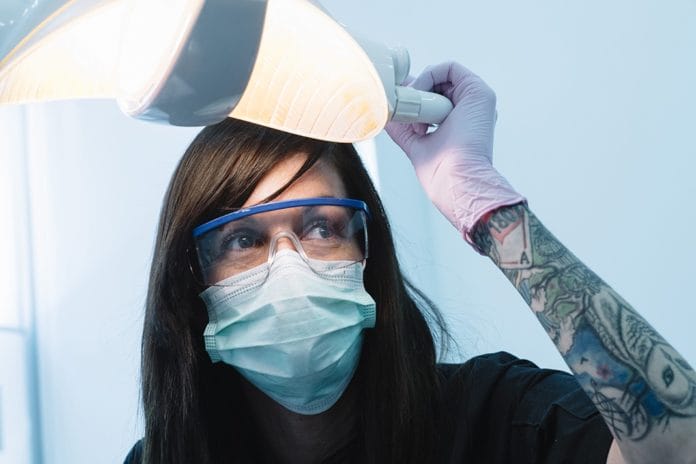The world in which we inhabit has vastly evolved over the years. Practices that were once frowned upon or considered rude or unprofessional are now more widely accepted. Among those new modernized ways of life is the tattoo.
Decades ago, it was a rarity that people inked their skin with colorful art much less proudly displayed it for the world to see. This once unorthodox concept is now broadly accepted, especially among the younger generations. Instead of asking who has a tattoo, it almost seems highly more appropriate to ask where your body is tattooed.
How does the professional world view these pieces of permanent expression? Are they hindering highly qualified applicants from scoring a position or are people so mute to the trending ritual that it isn’t even a factor?
A few weeks ago, I ran across a thread on a Facebook dental hygiene page inquiring about tattoos in the workplace. This topic caught my eye because surprise -surprise, I have three tattoos myself but only one visible in workplace attire. This thread received an abundance of action with most people in agreeance that tattoos should not be a deciding factor in one’s career. And again, most of those who commented had permanent ink.
My personal opinion is much the same. Because tattoos are so prevalent, it would be very challenging to seek employees without them. With that being said, I do feel that tattoos expressing vulgar content are a problem if they can be seen outside of the attire. While I can certainly understand both sides of this topic, I feel that a tattoo shouldn’t define a person.
National polling states that three in ten United States adults have a tattoo, with 47% of those being Millennials and 69% of those having multiple tattoos.[1] However, many job occupations require visible tattoos to be covered despite the mainstream acceptance of these expressions of art. Research suggests individuals with visible tattoos are perceived as less intelligent, professional, approachable, trustworthy, and kind.[2] A CareerBuilder.com study reveals that 31% of surveyed employers ranked “having a visible tattoo” as the top personal attribute that would dissuade from promoting an employee.[4]
Studies conducted in dentistry suggest that dentists perceived tattooed dental hygienists negatively when compared to a dental hygienist without visible tattoos.[2] Patients also perceived dental hygienists with large visible tattoos less professional than those without or having smaller visible tattoos.[2]
Dental hygiene schools were also polled on their policy and views on visible tattoos. Of the 340 dental hygiene directors polled, only 141 responded. The majority (80%) of the respondents reported that their programs did have a dress code policy on visible tattoos and 14% responded that their policy applied exclusively to students.[2] The majority of program directors also felt that dental hygiene schools should educate students on the impact of visible tattoos in future employment opportunities. Participants went on to say that they felt the community would view the school as less professional if the students had visible tattoos.[2]
Despite the potential negative stereotype visible permanent ink can present, some professionals choose not to allow it to hinder their success. The former Executive Editor of the New York Times, Jill Abramson, has visible tattoos on both biceps that she proudly displays. Not only was she the first female Executive Editor in the Times 160-year history, but in 2012, she was ranked number 5 on the Forbes list of most powerful women.[3] Bank of America spokeswoman, Ferris Morrison, states that the company has no policy on inked employees. “We have no formal policy about tattoos because we value our differences and recognize that diversity and inclusion are good for our business and make our company stronger,” she said.[4]
While many workplaces are more lenient on visible tattoos, it does seem to appear that health-related fields implement a stricter policy on inked employees. Reputable health institutions such as Mayo Clinic, UCLA, and Cleveland Clinic have long recognized policies on requiring all visible tattoos to be covered. While tattoos do not seem to hinder a medical professional from obtaining employment, one may be required to conceal it and save the tattoo flaunting for later.
Need CE? Click Here to Check Out the Self-Study CE Courses from Today’s RDH!
Listen to the Today’s RDH Dental Hygiene Podcast Below:
References
- The Harris Poll. Tattoo Takeover: Three in Ten Americans Have Tattoos, and Most Don’t Stop at Just One. PR Newswire: Press Release Distribution, Targeting, Monitoring, and Marketing. 29 June 2018. Retrieved from www.prnewswire.com/news-releases/tattoo-takeover-three-in-ten-americans-have-tattoos-and-most-dont-stop-at-just-one-300217862.html
- Search, K.R., et al. A Study of Visible Tattoos in Entry-Level Dental Hygiene Education Programs. Journal of Dental Hygiene. February 2018, 92 (1) 6-15. Retrieved from http://jdh.adha.org/content/92/1/6#ref-16
- Monty, L. Workplace Tattoo Taboos Fading. USA Today. 11 Sept. 2014. Retrieved from www.usatoday.com/story/news/nation/2014/09/11/tattoo-taboo-workplace/15449719/
- Hennessey, R. Tattoos No Longer A Kiss Of Death In The Workplace. Forbes. 30 July 2014. Retrieved from www.forbes.com/sites/rachelhennessey/2013/02/27/having-a-tattoo-and-a-job/#21a76da816dc












